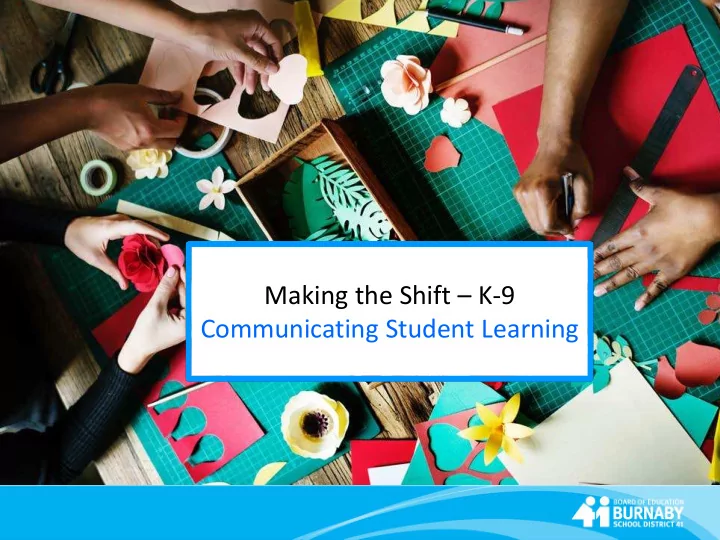

Making the Shift – K-9 Communicating Student Learning
Why Shift?
Click to add text Where are they going to next?
Jennifer % Teresa % 55/60 = 92% 23/60 = 38% Formative assessment – pretest 24/25 96% 16/25 64% Oral presentation 20/20 100% 15/20 75% Research article reflection 29/30 97% 29/30 97% Quiz #1 35/40 88% 40/40 100% Synthesizing project 27/30 90% 29/30 97% Quiz #2 22/25 88% 25/25 100% Group presentation 53/60 88% 59/60 98% Summative test 91% 93%
Jennifer % Teresa % 55/60 = 92% 23/60 = 38% Formative assessment – pretest Oral presentation 24/25 96% 16/25 64% 20/20 100% 15/20 75% Research article reflection 29/30 97% 29/30 97% Quiz #1 35/40 88% 40/40 100 Synthesizing project % 27/30 90% 29/30 97% Quiz #2 22/25 88% 25/25 100 Group presentation % Summative test 53/60 88% 59/60 98% 91% 93% 91% 81%
Curriculum - past
“… we must educate in new and different ways if we are to prepare our children for a 21st century world. We can no longer focus education around the acquisition of knowledge - information is too easily accessible with the touch of a screen.“ Jay McTighe – Experienced educator, consultant and author
Curriculum - present All areas of learning are based on a “Know-Do- Understand” model. Three elements, Content (Know), Curricular Competencies (Do) , and Big Ideas (Understand ) all work together to support deeper learning. The Know and Do are Learning Standards. This reflects a standards-based pedagogy .
Driving KNOW (facts) Rules, signs, signals, vocabulary, etc DO (skills) Accelerate, brake, steer, park, turn, etc UNDERSTAND (conceptual understanding) How to share the road, decision making, road patterns, how to adjust for weather From Katie White
Student ownership and engagement are achieved when students can articulate: • What they are learning (Understand, Know & Do) • How their learning is going relative to Understand, Know and Do • Explain where they are going next Students ability to answer these questions is fundamental for good teaching and forms the foundation for assessment.
Does what we report accurately reflect our students’ true level of understanding? “How confident am I that the grades students get in my classroom/school/district are accurate, meaningful, and consistent, and that they support learning?” Ken O’Connor 2007 Do our assessment practices contribute to student confidence, or do they raise anxiety? “Confidence is about real optimism that develops from a sense that success is possible, even if it’s not immediate.” Tom Schimmer
What is the shift in CSL?
Traditional Assessment Standards-based Assessment Based on Assessment methods Based on learning standards and • • (tests, quizzes, assignments) proficiency. Uses a mix of assessments, Emphasizes most recent evidence • • participation, achievement, of learning and the trend. effort. May use penalties or extra Content is the vehicle to assess • credits. the competencies. Calculates a grade on all scores. • Focus on content. •
How the Ministry of Ed is shifting…
Proficiency scale
Proficient “yes or not yet” From Katie White
Extending “limitless” From Katie White
Developing “school” From Katie White
Emerging “precursor skills” From Katie White
Continuum of Learning Standards By Denise Ferreira
Student Sample By Denise Ferreira
Student Sample By Denise Ferreira
Video… • https://www.youtube.com/watch?v=M1CHPn ZfFmU
How is CSL shifting in Burnaby?
The district offered opportunities for school teams to work together at the school level to explore a variety of methods for documenting knowledge, skills and attitudes (and helping our students to document their learning) Sharon Jeroski facilitated the school conversations and discussed the myriad of opportunities and possibilities around Communicating Student Learning.
Tom Schimmer is an education author, speaker, and consultant from BC. This year, Burnaby is running a learning series with Tom focusing on Standards- Based Learning and how to make summative assessment meaningful. We are moving from “teach, teach, teach, teach, then monumental assessment” to continual assessment which gather’s precise information to guide our practice and allow us to individualize our instruction.
When assessing in classes, Burnaby teachers are: • Shifting from primarily focussing on summative assessment to focussing on formative assessment • Working collaboratively with students as evidence gatherers and communicators of student learning • Using more flexible methods/ways to communicate student learning
Options in Burnaby
FreshGrade Portfolios – paper and digital
What do students say?
Thank you
Recommend
More recommend